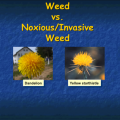- Body
Learn about non-natives vs. weeds vs. noxious weeds:
Not all Non-native Plants are Harmful
It is very important to be concerned about the damage that non-native, invasive plants can cause. However, it is also important to recognize that while most invasive plants are not native to the United States, not all non-native plants are invasive or harmful. Of the thousands of plants that have been purposely introduced into North America, less than 10% have become problematic invaders. Although there are plenty of “horror stories” involving introduced plants, many non-native, domesticated plants have proven to be beneficial to society as crops (e.g., corn and wheat), for landscaping, and for revegetation efforts on degraded or weed-infested lands. On the other hand, some native plants and animals can become invasive in certain settings (feral animals, mesquite, and juniper for example).
The term ‘naturalized’ is conventionally used to describe non-native plants that are capable of surviving and reproducing without human intervention for an indefinite period of time. Naturalized plants may or may not become invasive. Such plants that spread into new areas, survive, and that have a harmful impact to human health, economics, or ecosystem services are often referred to as invasive plants.
What is a weed and how does it differ from a noxious weed? Consider these 2 plants:

The plant on the left is one that most of you are probably familiar with -- common dandelion (Taraxacum officinale). On the right, is a noxious, invasive weed -- yellow starthistle (Centaurea solstitialis). While dandelions have certainly been problematic for anyone who has tried to maintain a ‘weed-free’ lawn, they have not impacted millions of acres as yellow starthistle has done in California. The point is, a weed to one person may be a desirable plant to another person – how a weed is defined really requires a value judgment. In order for a weed to be classified as “noxious” it must be regulated by law. This video Plants Out of Place provides a better understanding of weeds, noxious weeds, invasive plants and their impacts.Important historical pieces of legislation concerning noxious and invasive plants in the U.S. are the Noxious Weed Act of 1974 (as amended by the 1990 Farm Bill), the 1999 Executive Order on Invasive Species, and the 2000 Plant Protection Act. Go here for a list of weeds that are designated as noxious in Arizona, for an example. For additional reading on definitions, check out a ‘white paper’ located here (click on the first link under ‘Invasive Species Information’).
Get reliable rangeland science
Toggle Search